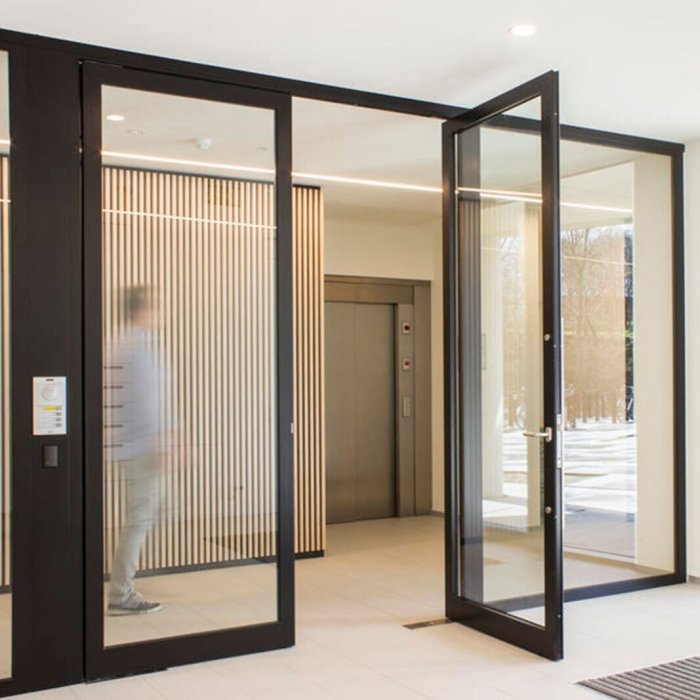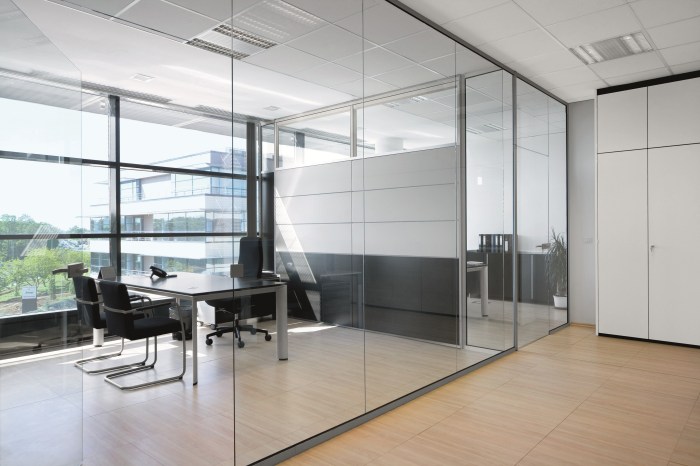Glazing is used in partitions and fire doors to enhance light transmission, visual connectivity, and fire resistance. This article explores the applications, design considerations, and installation and maintenance of glazed partitions and fire doors.
Glazing materials used in partitions include glass, acrylic, and polycarbonate, while fire-rated glazing materials used in fire doors include wired glass and laminated glass. The design of glazed partitions considers light transmission, privacy, and acoustics, while the design of fire doors focuses on fire resistance and visibility.
Applications of Glazing in Partitions

Glazing plays a crucial role in enhancing the functionality and aesthetics of partitions. By incorporating glazing into partition walls, architects can achieve:
Improved light transmission
Glazing allows natural light to penetrate deep into interior spaces, creating brighter and more inviting environments.
Enhanced visual connectivity
Glazed partitions provide visual transparency, promoting collaboration and communication between adjacent spaces.Various glazing materials are used in partitions, including:
Glass
Traditional glass offers excellent clarity and light transmission, making it a popular choice for both interior and exterior partitions.
Acrylic
Acrylic is a lightweight and shatter-resistant alternative to glass, providing similar optical properties at a lower cost.
Polycarbonate
Polycarbonate is an exceptionally durable and impact-resistant material, making it suitable for high-traffic areas or partitions requiring enhanced safety.Glazing designs and configurations vary depending on the specific application. Some common examples include:
Single-glazed partitions
These partitions consist of a single layer of glazing, providing basic light transmission and visual connectivity.
Double-glazed partitions
Double-glazed partitions feature two layers of glazing separated by an air gap, improving thermal insulation and soundproofing.
Framed partitions
Framed partitions use aluminum or wooden frames to support the glazing, providing structural stability and a clean, modern aesthetic.
Frameless partitions
Frameless partitions eliminate the need for visible frames, creating a seamless and minimalist look.
Glazing in Fire Doors: Glazing Is Used In Partitions And Fire Doors
Glazing in fire doors serves two critical functions:
Fire resistance
Fire-rated glazing materials maintain the fire resistance of the door, preventing the spread of fire and smoke.
Visibility
Glazing allows occupants to see through the door, facilitating safe evacuation and providing situational awareness during emergencies.Fire-rated glazing materials used in fire doors include:
Wired glass
Wired glass contains a wire mesh embedded within the glass, which helps to hold the glass together in the event of fire.
Laminated glass
Laminated glass consists of multiple layers of glass bonded together with an interlayer, which prevents the glass from shattering into dangerous fragments.The use of glazing in fire doors is governed by regulations and standards, such as the International Building Code (IBC) and the National Fire Protection Association (NFPA).
These standards specify the minimum fire resistance rating required for glazing in fire doors based on the specific application.
Design Considerations for Glazed Partitions and Fire Doors

When designing glazed partitions and fire doors, several factors must be considered:
Light Transmission
The amount of light transmitted through the glazing should be carefully considered to balance natural illumination with privacy and glare control.
Privacy
Glazing can be combined with other materials, such as frosted glass or blinds, to provide privacy while maintaining light transmission.
Acoustics
Double-glazed partitions and laminated glass can help reduce noise transmission between adjacent spaces.
Structural Considerations
Glazed partitions must be designed to withstand the weight of the glazing and any potential impact forces. Seismic performance must also be considered in areas prone to earthquakes.
Fire Doors
The placement and size of glazing in fire doors must comply with regulations and standards. The integration of glazing with door hardware, such as panic bars and closers, must be carefully considered to ensure proper operation in the event of a fire.
Installation and Maintenance of Glazed Partitions and Fire Doors

Proper installation and maintenance are crucial for the performance and longevity of glazed partitions and fire doors.
Installation
Glazed partitions should be installed according to the manufacturer’s instructions, using appropriate framing, glazing, and sealing techniques. Fire doors must be installed by qualified professionals to ensure compliance with fire safety regulations.
Maintenance, Glazing is used in partitions and fire doors
Regular cleaning and inspection of glazed partitions and fire doors are essential to maintain their appearance and functionality. Cleaning should be done using non-abrasive cleaners and soft cloths to avoid scratching the glazing. Fire doors should be inspected annually by a qualified technician to ensure proper operation and compliance with fire safety codes.
FAQs
What are the benefits of using glazing in partitions?
Glazing in partitions enhances light transmission, visual connectivity, and space division.
What types of glazing materials are used in fire doors?
Fire-rated glazing materials used in fire doors include wired glass and laminated glass.
What are the design considerations for glazed partitions?
Design considerations for glazed partitions include light transmission, privacy, acoustics, and structural performance.